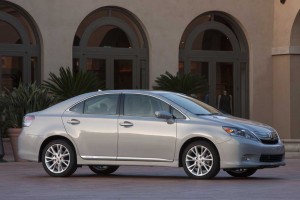
The 2010 Lexus HS250h is the world's first dedicated luxury hybrid.
The Toyota Prius is the world’s most popular hybrid-electric vehicle. It’s also the most distinctive. Indeed, it may be one of the easiest cars on the road to recognize, a factor that’s definitely played well to folks who like to make their “green” leanings as obvious as possible.
So it should come as no surprise that Toyota decided to use the same strategy when it began working up the design for the fourth hybrid offering from its luxury division, Lexus. The 2010 Lexus HS250h is also the brand’s first HEV-only model. Unlike the RX400h, LS600h and GS450h, the new HS is being offered with only a battery-electric powertrain.
To get a better feel for the 2010 Lexus HS250h, we headed out West to drive the sedan along the environmentally-friendly, in sentiment anyway, Los Angeles coast. The new sedan isn’t quite as distinctive as the love-it-or-hate-it Prius design, though it’s decidedly different from anything else in the Lexus line-up, inside and out.
Despite some earlier reports, the HS250h isn’t a rebadged Prius. In fact, it shares much of its underlying platform with Toyota’s midsize Avensis – essentially a European version of the Camry. So, while it’s designed to slot into the Lexus line-up alongside the IS sedan, the HS is actually a wee bit longer, and a fair bit taller.
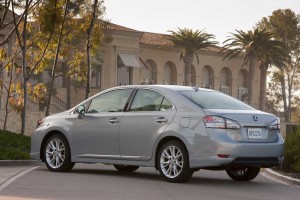
Despite some reports, the Lexus HS250h is based on the European Toyota Avensis, not the Prius hybrid.
While the design team attempted to maintain a familial resemblance, borrowing from the Lexus L-finesse design cues, the dominant theme is aerodynamics – one of the ways to maximize fuel economy. As a result, just about every detail of the new HS250h exterior is meant to cheat the wind, from the unusually low front air dam to the steeply raked windshield, the slab sides to the detailing of the taillights. The grille is a notable example; it’s designed to lift the wind over the hood, rather than pass it through to the engine, normally a major source of aerodynamic drag.
The shape is definitely distinctive, and is certain to be polarizing. But whether it will shout “hybrid” remains to be seen.
The interior is finished in what Chief Engineer Hiro Koba likes to call “ecologically-based materials.” About a third of the fabrics and even the plastics are derived from plant sources, rather than the traditional petroleum distillates.
The cabin is reasonably lavish, but the trade-off is that it doesn’t have quite the up-market feel of either of Lexus’ other two entry-luxury sedans, the IS and ES models. It seems a bit more Toyota than Lexus inside. The 2010 HS250 h is also quite cluttered, with a stupefying array of buttons, knobs, dials and displays.
To give Lexus designers their due, they’ve done an admirable job of focusing on ergonomics. They’ve divided displays up into three key components, including a new Heads-Up Display, or HUD, to the high-mounted navigation system and multi-information display. But there’s just so much to touch, turn or tweak, that it gets a bit overwhelming.
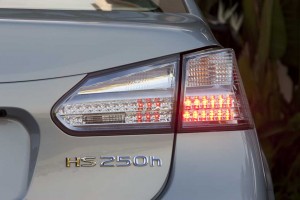
When you're trying to maximize mileage, even the most subtle details, like the design of a taillamp lens, can impact mileage.
On the positive side, the tall seating position translates into an unexpectedly roomy cabin, with plenty of storage and cubbies, including a huge glovebox. The eco-carpeted trunk, meanwhile, is the biggest of any Lexus hybrid, with more than enough room for four full-size golfbags.
There is one significant design flaw that needs pointing out, especially if you’re more than 6-foot tall. The hybrid shifter rides atop a quirky sort of island that floats out of the center stack and rises well about the center console. Unfortunately, there’s a small ridge beneath the shifter that tends to jab at the right knee on taller drivers and can get downright irritating after just a little time behind the wheel.
As you’d expect of any new offering from Toyota’s high-line marque, the HS offers an array of high-tech features, including that HUD, a Wide-View Front Monitor, 10 airbags and a safety system designed to anticipate a crash and take steps to either avoid the collision or at least reduce its severity.
The HS250h borrows a neat feature from the recently-updated Lexus RX crossover: the Remote Touch controller. With so many things to operate, the automaker has – like most of its luxury competitors – struggled to find a way to operate everything from one place, much like a computer mouse. The Remote Touch is a bit more like a track ball, using a swiveling handle mounted right where it comfortable falls into the driver’s right hand. It’s not a perfect solution, but it’s a nice alternative to the BMW iDrive and Mercedes-Benz COMAND system.
Detailing all the various techno-features on the HS would likely triple the length of this review, but it’s useful to note that they fall loosely into three categories: infotainment, safety and fuel economy.
One of the biggest infotainment assets is the audio system. Even the “base” package is a pleasure to listen to, but the optional Mark Levinson system is so good you may go out to your garage to check out a new CD or MP3 download.
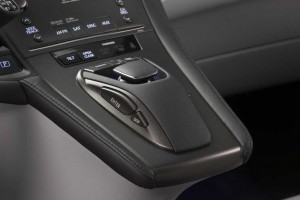
The Remote Touch on the 2010 Lexus HS250h is more like a trackball than a mouse, but it still makes it easy to control a variety of on-screen systems, like audio and navigation.
In terms of safety systems, it is likely to take us awhile to come to terms with the new Lane-Keep Assist, which adds a subtle bit of steering input when you inadvertently drift across the line. Meanwhile. Lexus has launched a new system, dubbed Enform, which offers many of the features first seen years ago on General Motors’ OnStar, such as roadside assistance and emergency crash notification. A nice addition is the ability to pre-program up to 200 destinations on your home computer then download them to the car’s navigation system.
On the driveline side, there’s a new heat recovery system that reuses much of the energy normally lost out the tailpipe. Instead, it helps warm up the engine more quickly which, in turn, allows the HS250h to switch to battery mode more frequently. Then there’s a new glass coating system for the windshield helps cut the solar infrared heat load by about 30%, which means less demand on the car’s mileage-robbing air conditioner.
The HS is rated ay 35 mpg City, 34 Highway, a reasonable though not absolutely exceptional level of fuel economy. (The less lavish Ford Fusion is delivering 41 mpg around town.) What we found surprising was that the sticker really did match the real-world performance of our test car, something that rarely occurs with hybrids, which typically deliver significantly poorer numbers on the road.
As a point of comparison, the Lexus IS250 gets 21 City/29 Highway, according to the EPA labs, while the ES350 is rated 19/27.
Under the hood, the HS250h is powered by a 2.4-liter, 16-valve inline-four engine that uses the more efficient (in fuel consumption, not power output) Atkinson Cycle, which holds the intake valve open longer during the compression stroke. On its own, it would deliver 147 horsepower. But when you power up the car’s electric drive system, that jumps to 187 hp.
A larger, heavier car than the Toyota Prius, the Lexus HS250h works hard when you’re launching it aggressively. It’ll keep pulling, however, as we discovered when we looked down at the speedometer as we cruised the Orange Country toll road, CA73, and discovered we were nudging 90 mph. At highway speeds, the engine can be raucous sounding, though generally smooth. Keeping it down below 65, the HS displays the same sort of quiet cabin tuning you expect of any Lexus.
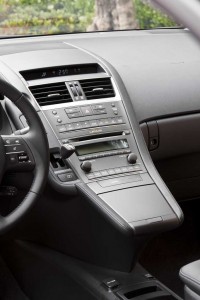
That small bump, to the left, where the shifter sits, can jab into the knee of a tall driver.
Like many hybrids, its gas/electric gearbox functions much like a Continuously Variable Transmission, so there’s a sometimes disconcerting phenomenon known as “rubber-banding,” where the engine’s RPMs effectively disconnect from road speed. It takes a bit of time to get used to the feeling that the car has to catch up to the engine.
The HS can be operated in any of several different modes, including normal, Sport and ECO. The latter lags throttle response so the car won’t respond as aggressively as a heavy-footed driver might want. There’s also an EV mode which will try to keep the HS running solely on battery power, where possible. That usually means at speeds up to around 20 mph. But while Chief Engineer Koba-san told us not to expect more than a mile on a fully-charged set of nickel-metal hydride batteries, we actually got more than 2 slowly cruising along one quiet coastal route.
For those who will want to test Sport mode, the HS250h seems definitely more responsive than the Toyota Prius, launching from 0 to 60 in a decent 8.4 seconds. Meanwhile, the double-wishbone rear, with its torsion beam, keeps the car flat and composed, even in aggressive cornering maneuvers.
We’ll have to wait awhile to see what Lexus decides to charge for the HS250h. But we’re expecting the sticker to come in at an unexpectedly low figure, in keeping with the surprise base price of the newest Toyota Prius.
Though it’s the fourth hybrid in the Lexus line-up, the HS could appeal to a very different buyer. The first three models used hybrid technology to put an emphasis more on performance than mileage. The new car is unabashedly focused on fuel economy. So, the reality is that most customers interested in the 2010 Lexus HS250h likely won’t ever push it to its limits. They’ll more likely try to hyper-mile it, seeing just how much better fuel economy they can get out of the car than the sticker promises.
How many such customers are out there remains to be seen. Lexus claims at least 1,000 orders were in hand before the first HS250h reached U.S. showrooms. But it’s also cut its sales forecast to a modest 25,000 of the hybrid sedans annually. That, General Manager Mark Templin admits, is less than what the Toyota luxury arm was originally aiming for when development work began on the HS.
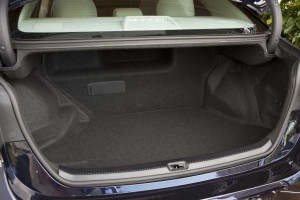
The tall seating position of the 2010 Lexus HS250h means a roomy cabin and enough trunk space for four large golf bags.
Of course, with fuel prices on the rise, again, things could change in a hurry. The 2010 Lexus HS250h is definitely a niche vehicle, with an assortment of its own quirks. But with mileage more important to American motorists than it has been in a decade, $4 a gallon gas could absolve it of a lot of minor sins.

This will be the first for putting 4 cylinders engine in a Lexus. Presumably they could offer V6 with a feature of shutting 2 cylinders off in city mode, yet they are confident of having more attractiveness in affordability. And 35 mpg for city traffic is not bad at all!
I drove it. It’s exactly what they claim it is. It is chock full of technology and has nice acceleration, for a car that emphasizes fuel economy. The fit and finish are very good, though not quite as luxurious as the rest of the Lexus line, but that’s OK with me. The one I drove was $40k, but it was loaded. Delete the tech package and the backup camera and you’re at about $36k-not bad for what you get. My guess is that resale value will be high on this car.